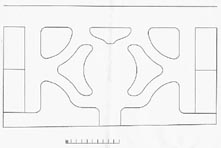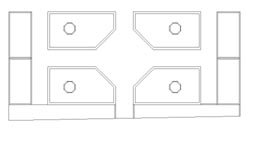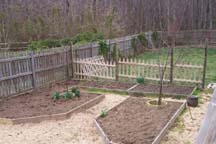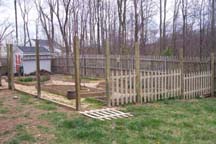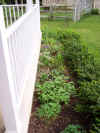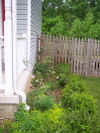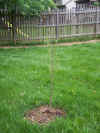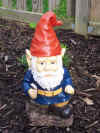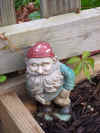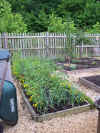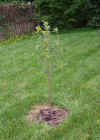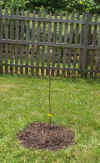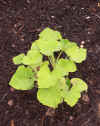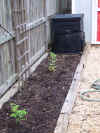 |
|
|
Latest Update: 6/23/04 May 12, 2004 -- Ok, first things first: this is not a 100% accurate 18th century garden. It is a garden made more or less in the 18th century fashion. I'm not sticking strictly to period plant varieties. For instance, the roses along the back fence are "New Dawn", a climbing variety that I like very much. The apple trees are "Sops of Wine" (which dates from the 13th or 14th century) and "Stayman Winesap" (which dates to the 19th century), and the grape varieties are modern red seedless grapes, because that's what I want to eat. The garden does, however, combine herbs and flowers, rather than segregating them (impossible, anyway, since many herbs have nice flowers and vice versa). The pear trees are "Red Anjou" and "Beurre Bosc". Raised beds laid out on a grid plan were common from the middle ages through the end of the 18th century. I like the feeling of order and logic that the raised beds convey. The end effect I want is one of controlled chaos, actually -- I expect the plants to fill up and spill over the boards, cottage-garden style, softening the formality of the layout. The vegetable beds, which were constructed shortly after we moved into this house, frame the garden, and the flower/herb beds are in the center. The paths between the beds are pea gravel, which need to be raked and weeded periodically. I will be adding a birdbath or sundial as a focal point to the center of the garden, once I find one that I like. Some flowers -- 1. Apple blossoms; 2. Pear blossoms; 3. Tulips: |
|
|
This is the garden we planned when we moved into the house, in 1999: As you can see, The beds were a different shape entirely, dug into the rock-filled clay and impossible to maintain. I amended the soil somewhat, but the clay was just too difficult to dig into to make the beds deep enough for proper planting (you literally need a mattock and pickaxe to dig into this soil -- and my back wasn't up to the task). As a result, the ground was impossible to work, got brick-hard in dry weather and boggy in wet weather, and at the end of each summer, the garden was filled with weeds, since the clay made it difficult to pull weeds out. Many of the plants I planted died. The only successful parts of the garden were the veggie beds (shown in the original plan, above) at either end of the garden; these were raised beds from the start, and were much easier to plant and maintain than the flower beds. After four years of struggling with the horrible soil, I decided that the garden needed a complete overhaul. Here are pics of the garden at the beginning of April, this year; Dad and I built the raised beds last fall, and started filling them with dirt this spring. I ordered a whole dump-truck load of dirt -- 16 cubic yards. We used all of it except for about four wheelbarrow loads in the new garden beds. The apple and pear trees were planted about four years ago, and I had to put in 'moats' around the trees to keep the dirt in the new, raised beds from smothering them. I hope this approach is successful; they may yet be smothered by the new beds, but so far don't show any signs of stress. They may have enough roots under the garden paths that they'll survive. As you can see, the garden is being enclosed in its own fenced-off area, inside my already-fenced yard. This is to keep my two dogs, who love to dig, out of the garden. I planted a lovely bed of flowers along the far fence (next to the shed) last year, and almost everything I planted got dug up -- a considerable waste of time and money. (That bed has since had the remaining flowers relocated into the new flower beds and has been re-planted with black raspberry and strawberry plants, and has a composting bin at one end next to the shed.) The new fence will also have the added benefit of visually setting the garden off from the rest of the yard, helping to give it more of a colonial feeling. Many colonial gardens were fenced or walled in, to keep out wandering dogs and livestock. One bed that won't be enclosed in the new fence is the former herb bed. The dogs have managed to kill most of the herbs, and I'd like the herbs in closer proximity to the kitchen anyway; so this will become a flower bed with drought-tolerant plants and rocks strategically placed to keep the dogs from trampling on them. That's one of my dogs (Sparky, the Border Collie) at the bottom corner of the picture. The tree in the bed is a fig tree. I finally got a fig or two last Fall -- but, on eating them, discovered that they made my throat itch, so apparently I've become allergic to figs since I was a child. The fig has since been replaced with a quince tree from Miller Nurseries. Yes, I've tried quinces, and no, I'm not allergic to them. Also in this bed are two rosemary bushes, partially killed by last winter's frosts, but still alive enough to rebound. Because most of my effort this spring was concentrated on getting dirt in the new beds, I didn't get around to planting any spring crops of spinach, lettuce, or radishes. Maybe this fall... Link on kitchen gardens which talks about inter-planting crops As of today, we've got all the beds in the back mulched, except the former herb bed (maybe I should call that the Quince bed, now), which needs more dirt added. Last weekend we finished building the bed for the blueberry bushes on the other side of the house, and now need to fill it with dirt, plant the bushes, and mulch. Kevin wants that done before May 22, so we've got our work cut out for us. Books: Chart for
dates of first and last frost |
|
| Pics from May 9 (click on thumbnails to see larger pics): The dog is Molly, my English Shepherd, lying in the dirt of the quince bed. Planted: Nasturtium "Jewel", mixed colors, in asparagus bed. Oriental lilies "Siberia" (white, of course) and "Stargazer" -- I have my doubts about these. The bulbs smelled moldy, and I don't think they'll come up. Speaking of which, several of the raspberry bushes haven't leafed
out, and I hope they aren't dead... I may have kept them stored
in the 'fridge too long. Some of the asparagus crowns I bought
were mildewed when I planted them, and haven't come up, though there
are enough survivors to fill the bed adequately. |
|
| Pics from May 13: As you can see, the beds have mulch on them. We buried soaker hoses under the mulch, except in one bed, where I still need to bury the hose. In the first picture, the far beds along the fence have cucumber seeds (right) and beans (left), and two grape v ines planted in the center of each bed. The token boxwoods: Other pics: the raspberry bed, underplanted with strawberries, and the blueberry bed, half-filled with dirt. |
|
| Blueberries planted: 2 "Jersey", 2 "Blueray",
2 "Bluecrop", planted so that no two of the same kind are
next to each other, for better pollination. One of the blueberry bushes I bought from Miller hasn't leafed out, so I'm going to plant it on the off chance that it might leaf out eventually. I cut one of the stems, and it's still green, so it might live. |
|
| 5/16: Yesterday, we built a new bed beside the deck, then had dirt left over when that was filled, and so built another bed in front of the fence, on the other side of the gate from the blueberry bed. We had a few wheelbarrow loads of dirt left after filling the second bed, so that went into the far back corner of the yard, where the dogs have dug a couple of craters. Yesterday was a hot day, but there was a breeze and it wasn't horribly humid. Today, I ache... I think I'm going to sit around and do nothing. I looked carefully at the black raspberries that aren't leafing out, and am pretty sure they're dead. My fault -- I'm fairly sure I planted them too deeply. Miller Nurseries has graciously agreed to replace them, and I ordered four red currant bushes as well, to put in the bed by the air conditioner. Sometime in the next week or two, I want to get some landscaping
timbers and put them around the air conditioning unit, then put
newspapers down to smother the grass and put gravel inside the
timbers. That'll make it easier to maintain that area of the
yard -- the weed trimmer has damaged some of the insulation, and it'll
be better to eliminate the grass there entirely. The unit is
rather unattractive, but according to the homeowner association rules,
we can't screen it with lattice. Maybe eventually I'll put in
some more bushes or other shrubs on that side of the house. This morning I planted some seeds for Long Island Cheese Pumpkins in the pumpkin bed. I think the seeds are only a year or two old, and should be fine. If not, I'll just have to mulch the bed and use it for something else until next year. One of my coworkers asked if I have pictures of the rest of the house. I didn't, so this morning while I was taking pics of yesterday's work, I took pictures of the house and some of the other plantings we've done. You can see where the remains of the dirt pile are on the driveway. The pile originally covered the entire left half of the driveway. Sixteen cubic yards of dirt -- I can't believe we moved the whole thing! To the right, you can see a grouping of three river birch trees. The middle one was a housewarming gift from my grandparents when we bought the house. I added the other two three years later. That bed needs to be expanded a little more, as the trees are larger. Behind the birch trees, along the neighbor's fenceline, you can see
three apple trees. The two in front, planted this year, are
Sweet Paradise apples, a favorite Pennsylvania German
variety for making apple schnitz, and the one in the back, planted
several years ago, is a Lady apple, a variety that dates back
to ancient Rome. I also finished up the quince bed yesterday morning, more or less. The bed has a path left in it for the dogs; if I didn't leave them a path, they'd trample the plants and wear a path in it anyway. The rocks in the bed will hopefully help keep them on the path, and protect the plants -- I hope that they'll be less likely to trample on plants next to rocks. I am thinking about putting some sand on the 'dog trot' to keep their feet from getting so muddy, but am not sure if they'd just start walking on the beds instead. Sparky, the border collie, runs away whenever you point a camera at
him, so I've got a nice picture of him retreating along the dog path
in the bed. The elm tree we planted this spring, which is supposed to be
resistant to Dutch Elm Disease: |
|
| May 28, 2004: The Cicada invasion has passed us by. Apparently, we live in a different Brood Zone, and will get invaded in 2013, if then. |
|
| June 23, 2004: A couple of updates -- First, the garden seems to have been infested by a couple of gnomes. How this happened I don't know, but one clearly appears to be inviting viewers to pull his finger, while the other is clearly enjoying a bit of flatulence. Oh, well, that's gnomes... nothing if not earthy! |
|
| Last Saturday, my hubby and I built trellises for the
beans and cucumbers. They're movable, so I can rotate the
plantings in the beds every year (which helps prevent pests that
plague a particular type of vegetable from getting too strong a
foothold).
The tomato and asparagus beds look pretty good, too. |
|
| The elm tree is looking ok, if a bit chewed on by
Japanese beetles:
I planted a Seckel pear tree last week, but when it arrived, the
leaves were black. Not a good sign. Still, there is a tiny bit
of green showing, so I planted it, and crossed my fingers. The
Seckel is a variety that developed in Pennsylvania in the 18th
century, and is a smallish variety that is supposed to be sweet, used
often for canning. (Note: if you want proof that gardeners are crazy, I was out in a rainstorm that dumped three inches of rain on us in about an hour, planting this thing, because I wanted to get it in as soon as possible. Later that evening, we discovered that the well for the new egress window into the basement had filled with water and was leaking into the basement. I went into the basement, opened the window, and started tossing the 10 or so toads/frogs that had been inhabiting the window well up and out. If anyone had been silly enough to be out in the rain, they'd have seen small toads come flying up out of the window well like popcorn.) Red currant bed, with window well to one side -- the bushes are
doing fine: More misc pics: Bonica rose and the replacement New Dawn rose, which is doing fine: Horseradish (first pic) and rhubarb cutting (second pic), brought
back from Bedford week before last and planted. I was worried
they didn't make the trip in a hot car, but they seem to be
recovering. I'm going to get a couple of planters for these -- they're
currently in the 'pumpkin' bed -- because they can grow pretty
vigorously and I want them contained. Long Island Cheese Pumpkin plants: when mature, these will have
lovely dark-green leaves with silvery veins. (Presuming the
seeds I saved from last year's pumpkins breed true...) I decided I'd made a mistake in underplanting the raspberries with
strawberries. They're both shallow-rooted plants, and will
ultimately be competing with each other for water and nutrients.
(Only three of the six bushes in the bed look like they're alive, at
this point, though I'm told they'll spread vigorously soon
enough.) So the strawberries came out and went to my mom's
house, leaving the raspberry plants. It looks a bit bare
now... I'm going to add one more composting bin. The madder pot on the deck, and the mint under the deck (which may
be a mistake, but I figured it will smother out the weeds that like to
grow there): The Sops of Wine apple tree has some nice fruit on it; this'll be
the first year it's borne fruit. I went looking online for some pictures of Seckel
pears, and found, instead, a collection of botanical watercolors
that show fruit
diseases. These look like something Morticia Addams would
frame and put on her wall. |
|
|
Books: For Every House a Garden: A Guide for Reproducing Period Gardens by Rudy J. Favretti, Joy P. Favretti |
|
|
|
|


